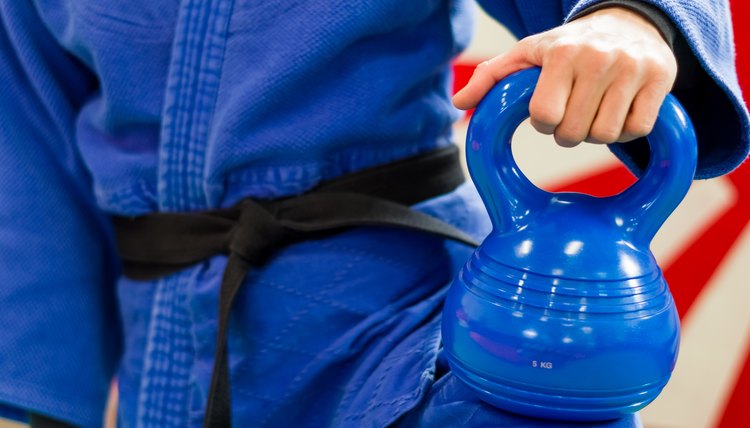The Significance of the Blue Judo Uniform

The judo uniform, or judo gi, consists of cotton drawstring pants and a matching quilted cotton jacket. A colored belt is worn to indicate the practitioner's rank. The uniform was adopted in the late 19th century, at which time white was the traditional color for the pants and jacket. In the 1980s, blue was adopted as an alternate color in some competitions to distinguish one opponent from the other. The use of one blue and one white judo gi in competitions has since become commonplace in many competitive circles.
History of the Blue Judo Gi
Anton Geesink first suggested the use of the blue judo gi during the Maastricht IJF DC meeting in 1986. At that time, no international standards were in place to differentiate two contestants from one another during a match. In Japan, one contestant would affix a red sash to his belt, which would help to set him and his opponent apart, but both wore a white judo gi.
In other competitions, a colored sash was sometimes used as well, but without a standard means by which to distinguish contestants, judges and referees sometimes struggled to make the distinction. Geesink suggested the blue judo gi as a means of clearly distinguishing one contestant from another. The blue judo gi went on to become mandatory at regional and higher competitions, although many Japanese practitioners and purists continue to look down on the use of blue judo gi.
Using Color to Differentiate Between Opponents
The blue gi's only purpose is to distinguish one opponent from another during a match. By contrasting with the white gi of her opponent, the wearer of the blue gi makes it easier for the judges, referees and spectators to keep track of which contestant is which. The blue judo gi is not indicative of rank or skill. The color of the contestant's rank is indicated only by the color of her belt, not her gi.
Perceived Advantages of the Blue Judo Gi
During the 2004 Olympics, contestants who wore blue gi more often out-performed their white-clad opponents during matches. The tendency for blue to defeat white, regardless of how equally matched the contestants may have seemed in strength, size and skill level, created the perception that wearing the blue gi brought some sort of advantage.
Those who observed this phenomenon began to seek a causal link between the color of the contestant's gi and his performance, speculating that the darker color was perhaps more intimidating on a subconscious level, or that the darker gi made its wearer's movements harder to see, thus slowing the white-clad contestant's reactions to his blue opponent. The statistical evidence seemed to suggest that the blue gi held some advantage, but researchers were unable to put their finger on what, exactly, that advantage might be.
Scientific Study of the 2004 Olympics Phenomenon
Evolutionary biologists in Scotland and the Netherlands took it upon themselves to examine the 2004 Olympics phenomenon more closely. Their study found other factors that might have influenced the success of blue-clad contestants. For example, each contestant's gi color alternated between matches, and the higher-seeded competitors ended up wearing blue more often as a result.
When a contestant was due to don the blue gi, she was also likely to have had more rest since her last match. Blue-clad contestants were also likely to have been in more matches than their white-clad opponents, and their higher number of victories prior to the match in question indicated a higher skill level.
Having determined that the superior opponent was more often adorned in the blue gi, and that the color of her gi was coincidental, the researchers failed to discover any inherent psychological or visual effects of the blue gi that couldn't be more easily explained by rest and the wearer's skill.
References
Writer Bio
Rob Callahan lives in Minneapolis, where he covers style, culture and the arts for Vita.MN and "l'étoile Magazine." His work has earned awards in the fields of journalism, social media and the arts. Callahan graduated from Saint Cloud State University in 2001 with a Bachelor's degree in philosophy.
